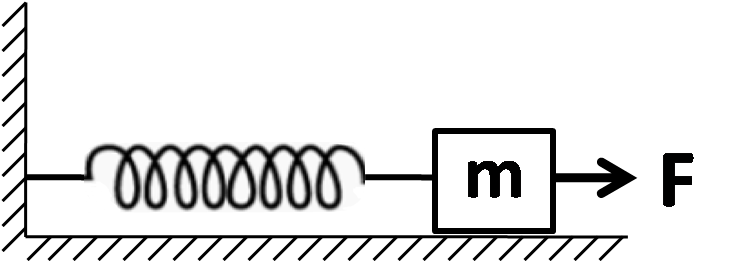Question
Question: A block of mass \( m \) lying on a smooth horizontal surface is attached to a spring of spring const...
A block of mass m lying on a smooth horizontal surface is attached to a spring of spring constant k . The other end of the end is fixed, as shown in the figure. The block is initially at rest in its equilibrium position. If now the block is pulled with a constant force F, the maximum speed of the block is:

(A) mkπF
(B) mk2F
(C) mkF
(D) πmkF
Solution
Hint
To solve this question, firstly we have to find the maximum extension of the spring. From there we can get the maximum potential energy of the block, which can be equated to the maximum kinetic energy to get the maximum speed.
Formula Used:
The formula used to solve this question is given by:
⇒U=21kx2 where U is the potential energy of a spring of spring constant k having extension x
⇒K=21mv2 Where is K the kinetic energy of a particle of mass m moving with speed v
Complete step by step answer
The situation is shown in the below diagram


We fix the origin at the initial position of the block. Now, on the application of the force F, we have the maximum extension xmax , which can be found by putting net force equal to zero at the maximum extension.
So, we have from the equilibrium of the block
F=kxmax
Or, xmax=kF (1)
Now, we know that the potential energy of a stretched spring is given by
⇒U=21kx2
So, the maximum potential energy of the stretched spring is equal to
⇒Umax=21kxmax2 (2)
We also know that the kinetic energy of an object is given by
⇒K=21mv2
So, the maximum kinetic energy is
⇒Kmax=21mvmax2 (3)
Since there is no friction, the total energy of the block remains constant. Also, we know that when the kinetic energy of the block is maximum, its potential energy is zero and vice-versa.
Therefore we can say that
⇒Kmax=Umax
From (2) and (3) we have
⇒21mvmax2=21kxmax2
Multiplying both sides by m2
⇒vmax2=m2×21kxmax2
⇒vmax2=mkxmax2
Substituting the value of xmax from (1), we get
⇒vmax2=mk(kF)2
⇒vmax2=mkF2
Finally, taking square root we get
⇒vmax=mkF
Therefore, the maximum speed of the block is equal to mkF
Hence, the correct answer is option (C), mkF .
Note
The same question can also be solved using the work-energy theorem. We just need to find the work done by the constant force and the spring force, which is to be equated with the change in kinetic energy, at the extreme position. But the first step to solve these types of questions, by any method is to find out the maximum extension of the spring.
